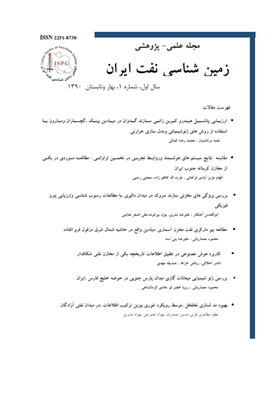کاربرد هوش مصنوعی در تطبیق اطلاعات تاریخچه یکی از مخازن نفتی شکافدار
محورهای موضوعی :ناصر اخلاقی 1 , ریاض خراط 2 , صدیقه مهدوی 3
1 - دانشگاه آزاد اسلامی
2 - پژوهشگاه صنعت نفت
3 - پژوهشگاه صنعت نفت
کلید واژه: تطبیق تاریخچه شبکه عصبی مصنوعی شبیه سازی عدم قطعیت Feed Forward,
چکیده مقاله :
یکی از کاربردهای عمده روشهای محاسبات نرم افزاری ،پیشگوئی نتایج فرایند های مختلف در صنایع نفت بوده است ،که اندازه گیری آنها با روش های متداول بدلیل غیر خطی بودن دارای جواب واحدی نبوده ویا اینکه یافتن جواب آنها بسیار وقت گیر وهزینه بر می باشد .بدلیل وجود عدم قطعیت در برخی از اطلاعات استفاده شده در شبیه سازی ها،پیشگوئی های این مدل ها با خطای بسیاری همراه است .در این راستا از اطلاعاتی نظیر فشار ،دبی وسایر اطلاعات تولید در طول عمر مخزن جهت تطبیق تاریخچه ومنطبق کردن نتایج شبیه سازی با واقعیت استفاده می گردد .در این مطالعه از شبکه عصبی (ANN)برای ساخت مدل پیش گویی کننده فشار ته چاهی یکی از مخازن نفتی شکافدار ،با تاریخچه تولید 7 ساله استفاده شده است .تخلخل شکاف ،تراوائی شکاف در جهت های افقی وعمودی ،ارتفاع بلوک ،تخلخل دو گانه ماتریکس -شکاف بعنوان پارامتر هایی که روی آنها عدم قطعیت وجود دارد بعنوان ورودی شبکه وفشار بعنوان خروجی برای ساخت شبکه بکار رفته اند . نتایج بدست آمده از این مطالعه نشان داد که ،با استفاده از 50بار اجرای سناریو های مختلف ،مدل تخمین گر با خطای کمتر از 4%ضمن کاهش زمان فرایند ،قابلیت مناسبی جهت تطبیق فشار ته چاهی را دارد .
Nowadays different methods of soft computing to reduce time and calculation content are widely used in oil and gas industry. One of the main applications of these methods is prediction of the results of different processes in oil industry which their estimation with usual methods is too difficult and has either no single response or their response finding need more time and cost due to their nonlinear of the related problems. Because of much uncertainty on information which used in simulators, the results of these simulation models may have lot errors so production data (Pressure, Production Rate, Water Oil Ratio (WOR), Gas Oil Ratio (GOR) and etc.) during reservoir life is used to historical accommodation between simulator results and actual data. The main purpose of this study is investigation and feasibility study of a usual method of artificial intelligence in oil industry, which is based on the soft computing. In this study, Artificial Neural Network (ANN) is used to make a predicting model for bottom hole pressure and for one of the fractured oil reservoirs with the seven years history of production. Some unconditional parameters such as fracture porosity, horizontal and vertical fracture permeability, height of matrix and matrix-fracture dual porosity were applied as input data of the networks, and pressure was applied as an output in network making. Applied data in network making is achieved from the 50 runs with simulator. The conclusion of this study showed that predicting model of ANN with error less than 4% and reduces the time of process, has a good ability to history matching.


